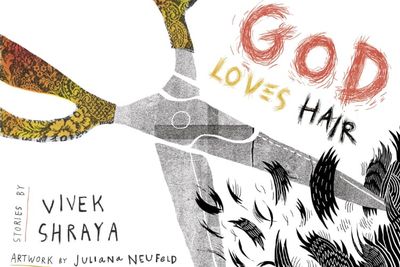Author Vivek Shraya will visit Parnassus Books on Sunday, December 7 and read from his debut young adult story collection, God Loves Hair. The reading is part of the "This is a Book for Parents of Gay Kids" book tour. It features twenty-one illustrated short stories about a young, queer Indo-Canadian boy navigating the realms of sexuality, gender, racial politics, religion, suburbia and belonging.
Written by celebrated multimedia artist and musician Vivek Shraya, God Loves Hair is a moving and ultimately joyous portrait of youth that explores diversity in all shapes, sizes, and shades.
The stories are accompanied by Juliana Neufeld’s award-winning, full-color artwork. The first edition was a finalist for a Lambda Literary Award and won the Applied Arts Award for Illustration. God Loves Hair has been approved by the New York City Council and NYC Department of Education as part of an initiative to bring LGBT-themed books into classrooms and libraries.
What was your inspiration for writing God Loves Hair? Who do you hope will read it?
My experience of growing up genderqueer in North America and with Hindu immigrant parents was often isolating. My inspiration for God Loves Hair was to write the kind of book that I needed [when I was growing up]—a book that explored these intersections. Consequently, I hope that the book reaches other queer and trans youth, youth of color, or anyone who has grown up feeling abnormal. The book is also dedicated to “the boy who was almost lost” and I think this is a universal experience for many of us, that sense that of childhood innocence stolen and attempting to rediscover these precious parts of ourselves later in life.
When you began writing the book, did you imagine it illustrated? How did you come to work with artist Juliana Neufeld?
The original idea was for it to be a children’s book with illustrations. But as the protagonist in the book matured, maintaining a child’s voice was limiting and unnatural. Having illustrations continued to be important to me. Part of my inspiration to create a children’s book was to include the kind of Indian aesthetic and images I didn’t see in books when I was growing up, including brown-skinned faces. I had met Juliana at a local queer hip hop party. A few months later, when I started writing, I knew she was the illustrator I wanted to work with. Working together on this project was one of the most rewarding collaborative experiences I have had as an artist. The richer her illustrations grew, the harder I worked to strengthen the stories.
External exploration—trying things on and seeing what fits—is a large component of childhood and adolescence. While I was shaping my own identity, I looked to my mother, my friends, Hindu gods, and movie stars for inspiration and guidance, which inevitably led to trying to outwardly transform myself into them. Perhaps these themes are more evident in a queer childhood, because often my explorations were met with a negative response, forcing me to try other, safer forms of expression.
What other writers/artists/texts influence your work?
God Loves Hair was largely inspired by Stone Butch Blues by Leslie Feinberg, as it was the first LGBT book I was exposed to. I didn’t realize that such a genre existed and more importantly, I profoundly connected with the protagonist. After reading the book, I wondered what my own story would read like. My favorite author is Jonathan Franzen, and I am inspired in art and in life by Beyoncé.
graphic provided
